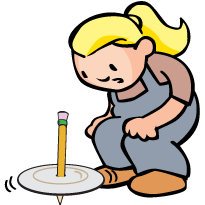Boston Children's Museum
308 Congress Street, Boston, MA 02210
617-426-6500
© Boston Children’s Museum 2025
Website Design by JackrabbitNow that your students have experimented with some of the basic design elements of homemade tops, they can play around with a new variable — the width of the plate used to make their tops. Will a top made with a wider plate spin longer, not as long or the same amount of time as a narrower top?
This activity is part of the Tops series of activities. Make sure you have tried the first activity, Tops, before trying this one.
Place all materials on a table at the front of the room. You can cover the tables that your students will be working on with chart paper, butcher paper or newspaper. Make sure to tape this paper down.

Ask your students about their experience making tops in the last Tops activity. What were some of the things that they could change to make their top spin better? Make a list of these observations on a piece of chart paper or a chalkboard. Tell them that you are going to give them some new materials to see if they can make a top that spins even longer.
Can you make a top that spins for at least 10 seconds, and can you figure our if wider or narrower plates help a top to spin longer?
After 10–15 minutes, bring your students together away from the materials to talk about what they have discovered. Does plate size make a difference? Ask each team to share their spinning times for small plates vs. large plates and write these results on a piece of chart paper or chalkboard.
Ask your students if there is anything else they have learned about making a successful top. If you have seen any interesting solutions while you observed the teams, try to ask questions of those teams that will encourage them to share their findings. Some other variables that children may be experimenting with include spinning the top on the eraser vs. the pencil tip; turning the plate face up vs. face down; adding binder clips to the outside edge of the plate, etc.
Have your students return to their construction. They may continue working with their original design, or start making a new top. Let them work until they have all achieved the 15-second goal. If some teams are struggling, observe these teams, paying special attention to their spinning technique (the 2-hand technique described in the last activity will improve their time); the location of the plate on the pencil (a plate lower down will work better); how tight or loose their plate is on the pencil (a loose plate will not spin well at all — a binder clip above and one below the plate on the pencil, pushed together so that they are squeezing the plate will help a lot); and anything else that you notice. Make sure not to give them these solutions, but ask them questions or refer to earlier conversations to help lead them to these answers.